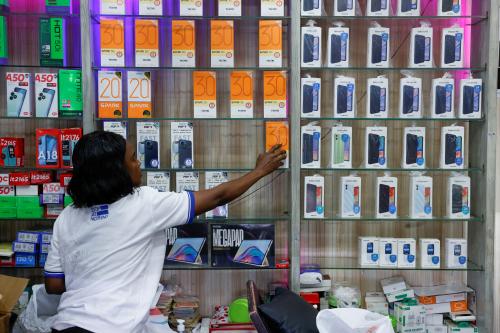The youth challenge is the most critical 21st century economic development challenge facing the Middle East. Navtej Dhillon, Fellow/Director of the Middle East Youth Initiative, co-presented at a panel of experts to congressional staffers from the Foreign Relations Committee on the implications and opportunities of the youth bulge and how states and outside organizations are trying to respond. Joining him were Honorable Marwan Muasher, Senior Vice President at the World Bank, and Ellen Laipson, President/CEO of the Stimson Center.
In my brief remarks today, I would like to make one central point: The youth challenge is the most critical 21st century economic development challenge facing the Middle East. In a region where almost 65% of the population is under the age of 30, long term prosperity and stability hinges on the opportunities afforded to this generation. While radicalism and terrorism remain critical security concerns, the majority of Middle Eastern youth are involved in a different fight: a fight for better education, jobs and affordable housing. It is on the back of this generation that the Middle East will build a future middle class – a middle class which can be a catalyst for more open and democratic societies. Therefore to advance U.S. interests in the Middle East, we need more than anti-radicalization strategy; we need a strategy that elevates youth-development alongside defense and diplomacy both in principle and practice.
Drawing both on our research at Brookings and a recent trip to Jordan, Syria and Lebanon where I worked with young people I would like to elaborate on this main thesis by focusing on three areas: first, to show that the Middle East is at a critical juncture and how a large youth bulge presents opportunities for growth and prosperity; second, to outline the main challenges facing youth in the region; and third, to showcase some of the implications for policy, especially U.S. policy with regards to the region.
Recognizing that the Middle East is at crossroads, we have to realize that there is a narrow window of opportunity to build a foundation for lasting prosperity. The region faces a scenario of double dividend or double jeopardy: for the first time in its modern history, the Middle East is simultaneously experiencing an economic boom and a demographic boon. The region is experiencing its best economic performance in three decades – oil and non oil producing countries alike are showing record growth. Second, the region has a large youth bulge, presenting a large pool of human capital which if used productively can usher growth and prosperity. If countries can take advantage of the confluence of these two historic gifts, they can create a virtuous cycle of higher growth, higher incomes and savings. Failure to do so will result in a double jeopardy: the economic and social exclusion of youth drains growth and creates social strife. But the time for securing this double dividend is now. The window of opportunity – where countries have fewer dependents – will close in the next ten to fifteen years.
Middle Eastern economies can seize this opportunity as many Asian economies have done. However, without urgent reform, the region risks missing this historic opportunity. Already, there are some alarming signs. Despite good economic growth, prospects for young people are not improving significantly or rapidly. This has been a central pre-occupation of the Middle East Youth Initiative – to understand why young people continue to be excluded.
I will be sharing some of the concepts and ideas that our studies and work have led to.
The majority of 15-24 and 25-30 year olds in the region are confronted with a new life phase we have termed waithood – a concept that refers to the bewildering time in which large proportions of Middle Eastern youth spend their best years waiting. It is a phase in which the difficulties youth face in each of these interrelated spheres of life result in a debilitating state of helplessness and dependency. Waithood can be best understood by examining outcomes and linkages across five different sectors: education, employment, housing, credit, and marriage.
Poorly prepared for the labor market by their educational systems, Middle Eastern youth face unemployment rates that are nearly twice the world average (20-40 percent compared to 10-20 percent). Furthermore, their queuing time for their first job is measured in years rather than months compared to their counterparts in Asia and Latin America. I’ve met many youth in the region who have waited 3-4 years for a public sector job.
With regards to housing – all the oil money flowing into the region has sent the costs of real estate soaring in urban cities. This often compromises young people’s ability to get married and lead independent lives. Furthermore, while credit allows youth in other parts of the world to smooth their future consumption, in many Middle Eastern countries, poorly functioning credit markets fail in their basic purpose.
As a result of not being able to afford a dowry, or a house, young Middle Eastern men are involuntarily delaying marriage, which in the region, is a rite to passage for adulthood, independence and legitimate sexual relationships. Today, the average age of marriage is on the rise in most Middle Eastern countries, imposing economic and social costs which have yet to be fully understood. All this compounds the dependency of youth on their parents.
So we get back to the question: why does this waithood persist even in good times? The root cause lies in the economic and social institutions and the signals they send which shapes behavior and decisions. Think of this as the invisible infrastructure – the rules of the game which organize society. In the Middle East, this invisible infrastructure is based on an education system which prepares youth for public sector employment, thereby reinforcing three problematic ideas. First, that a university education is the only prize worth pursuing. Second, the notion of a lifetime secure desk job. Third, that readiness for marriage is largely contingent upon both a university education and a stable job which only perpetuates the lure for degrees and desk jobs. But with globalization and privatization, this invisible infrastructure is no longer functioning as it should. Let me illustrate this concept with some examples and facts from the ground.
Parents in the region invest billions of dollars in private tutoring to increasingly prep their children for standardized tests, so children end up learning a narrow set of skills. Then donors and governments must spend resources re-training these very youth to given them a wider range of skills because of the limitedness and poor quality of their initial education. Public policy would be infinitely more effective if parents had the incentives to invest in broader skills, rather than governments and donors undoing the investment of parents.
Through a focus group we held in Jordan, we found that young men are willing to continue waiting for public sector jobs which may never materialize. They are not incentivized to search for a job in the private sector (informal or formal) because they feel the wait is much better than the stigma and insecurity attached to work in the private sector.
Why do youth who have lower opportunity costs not undertake more voluntary work? A Gallup poll in 2006/2007 asked Middle Eastern youth “in the last month, did you volunteer your time to an organization”. The regional average was just 11%; in countries like Jordan, only 4% of respondents answered yes. The reason is because youth and their families have no incentives to invest in volunteerism; neither public nor private sector jobs value these experiences, and universities base their decisions on nothing but national rankings on standardized testing.
But all is not lost – because here you have a region where parents are willing to do anything for their children; most youth are in school and spend years working for their future; and policy makers are increasingly more concerned about these issues.
Now I will touch upon the implications these challenges pose for policymaking with a particular focus on the U.S. perspective.
First, the youth challenges that the region is facing are driven by economic and social incentives, which in turn shape the decisions taken by millions of families and youth. Youth transitions constitute outcomes across several interconnected markets, most importantly in education, labor, credit, and marriage. Program and Policies need to exploit these inter-linkages. For example, if programs are going to provide credit to young people to start their own businesses, it is important to build-in clear criteria which are based not only on their diplomas but what they have achieved outside school to incentivize volunteerism and extracurricular activities.
Second, the chasm in U.S.-Middle East relations has emerged amidst greater convergence in ideas and aspirations. Triggered by a large youth cohort, the Middle East is undergoing change where it is aligning with fundamental drivers of globalization. The region has embraced the idea of market economy and values education. Middle Eastern youth ascribe to the fundamental pro-growth norms of behavior such as hard work and high investment in children including girls. There is a strong foundation to build a future middle class. These are all areas where the U.S. is a leader. As the country with the world’s best record in harnessing the energy of youth, there is much the U.S. can offer the Middle East. The U.S. relationship with the region should be cast on broader terms, making youth development as a template for exercising smart power.
Key recommendations include exporting soft technology for institutional reform of education. Youth in the U.S. have a relatively smooth transition to adulthood compared to most advanced countries. Transitions to adulthood in the US are facilitated because of the close integration between the education system and the labor market. The U.S institutional set up may not fit the Middle East perfectly, but as with all exports, soft technology exports can be adapted to fit local conditions. The educational system in the U.S. has already provided the region with great institutions of higher education – such as the American Universities of Beirut and Cairo—which have produced many of the region’s leaders. The US can extend assistance on a broader scale encompassing curriculum reform for high schools, the transition from high school to university (reforms of university admission practices), and the transition from school to work. Government should create incentives for greater collaboration between Middle Eastern and U.S. non governmental organizations, research institutes and universities.
The challenge is how the U.S. can build on its strengths and can be seen as genuinely interested in economic development. At the moment, there is a lack of instruments for such an exchange. In fact, currently, the Foreign Assistance Act does not have an explicit window to target funds for youth. The language of the Foreign Assistance Act should be changed to overcome this policy flaw. Youth development should be given priority, particularly in countries experiencing “youth bulge” and high rates of youth unemployment.
And finally, the discourse on the Middle East is highly and exclusively political and lacks an economic development focus. Addressing Middle Eastern youth solely through the prism of potential extremism misses the opportunity for aligning U.S. policy with the aspirations of the majority of the moderate citizens in the Middle East. It alienates the very people we are trying to help. Currently, there is re-negotiation of the rules of the game in the region, and it is being spurred by youth, who we should be empowering and supporting.
The Brookings Institution is committed to quality, independence, and impact.
We are supported by a diverse array of funders. In line with our values and policies, each Brookings publication represents the sole views of its author(s).



Commentary
Middle East Youth Bulge: Challenge or Opportunity?
May 22, 2008